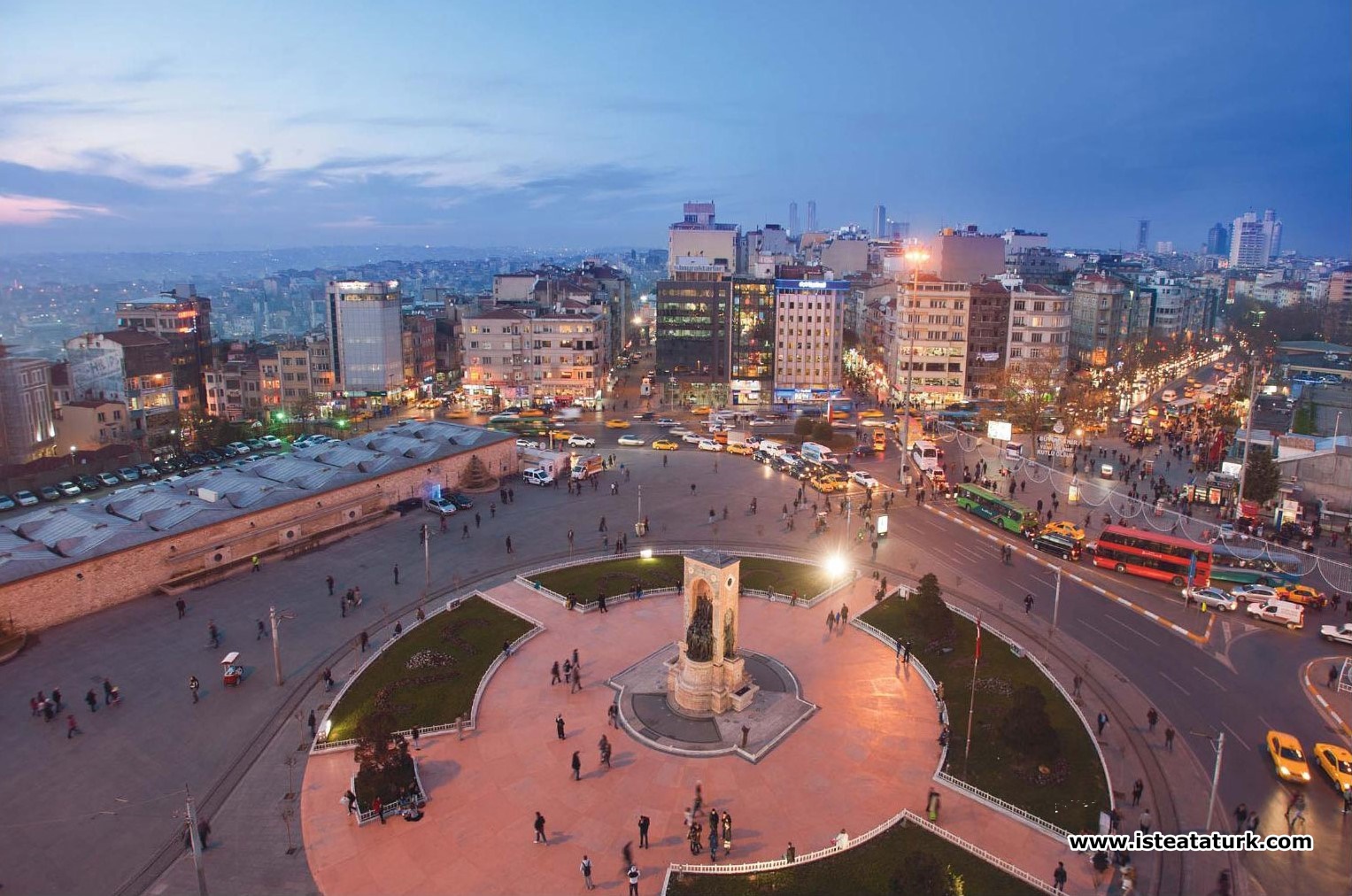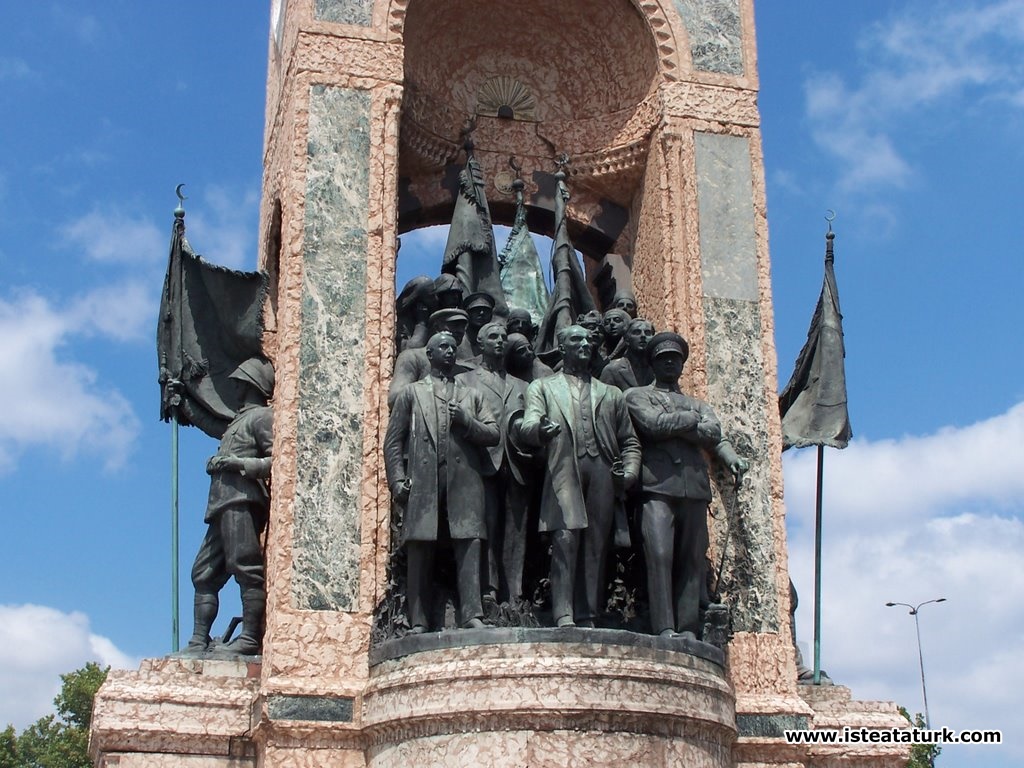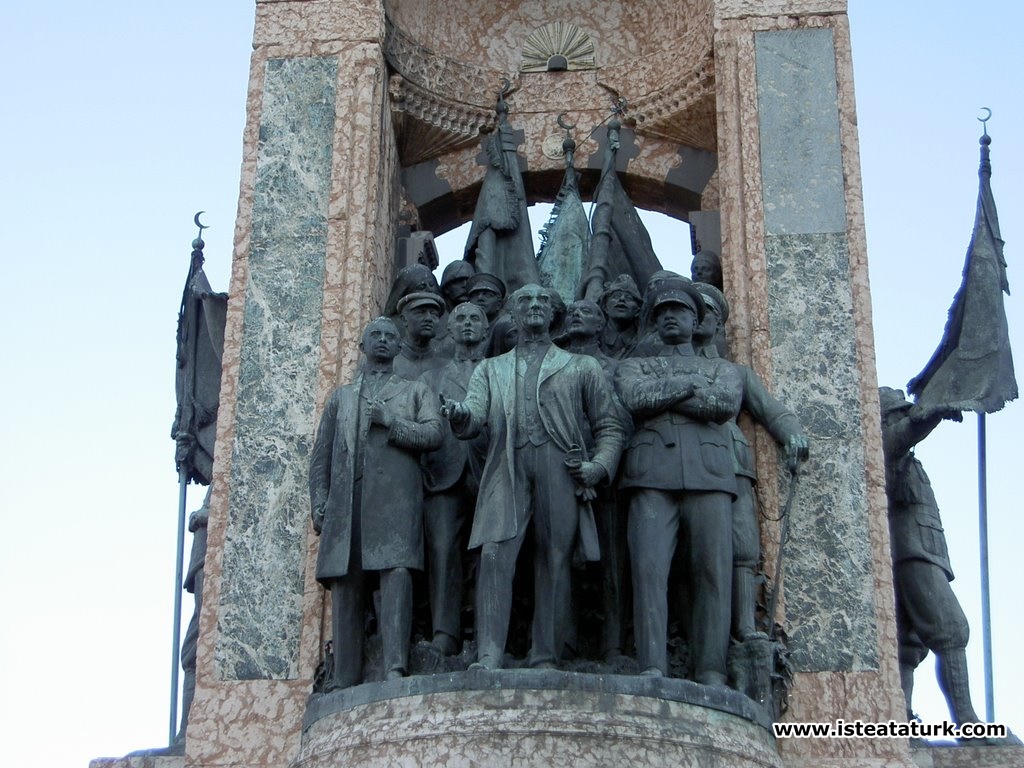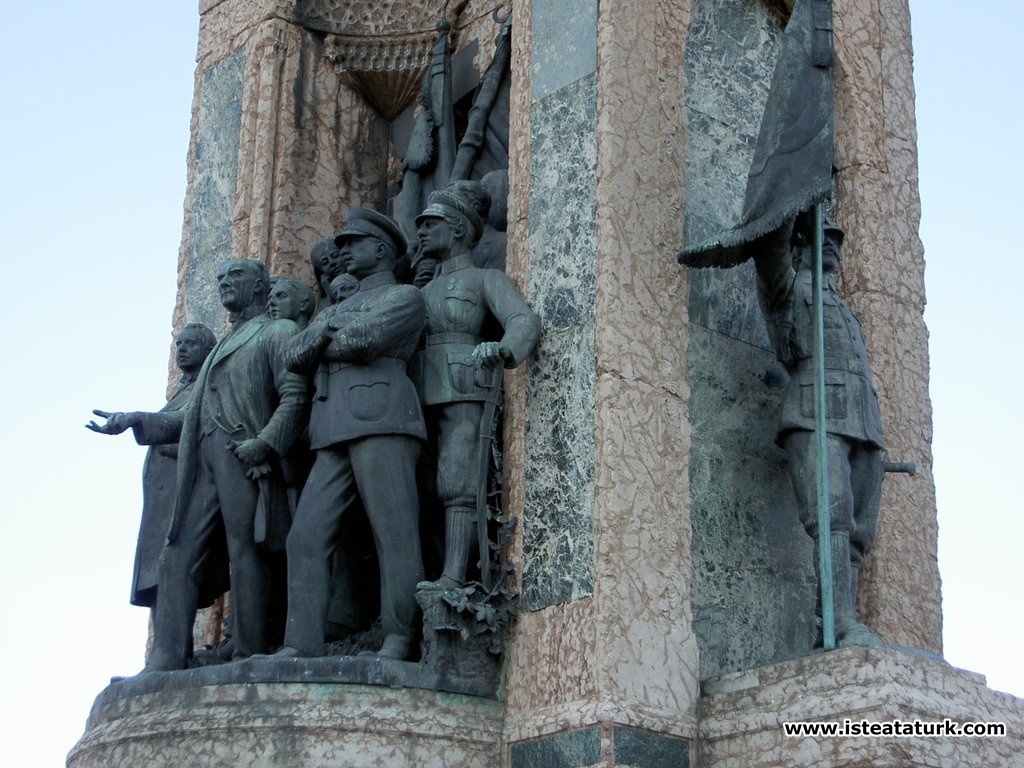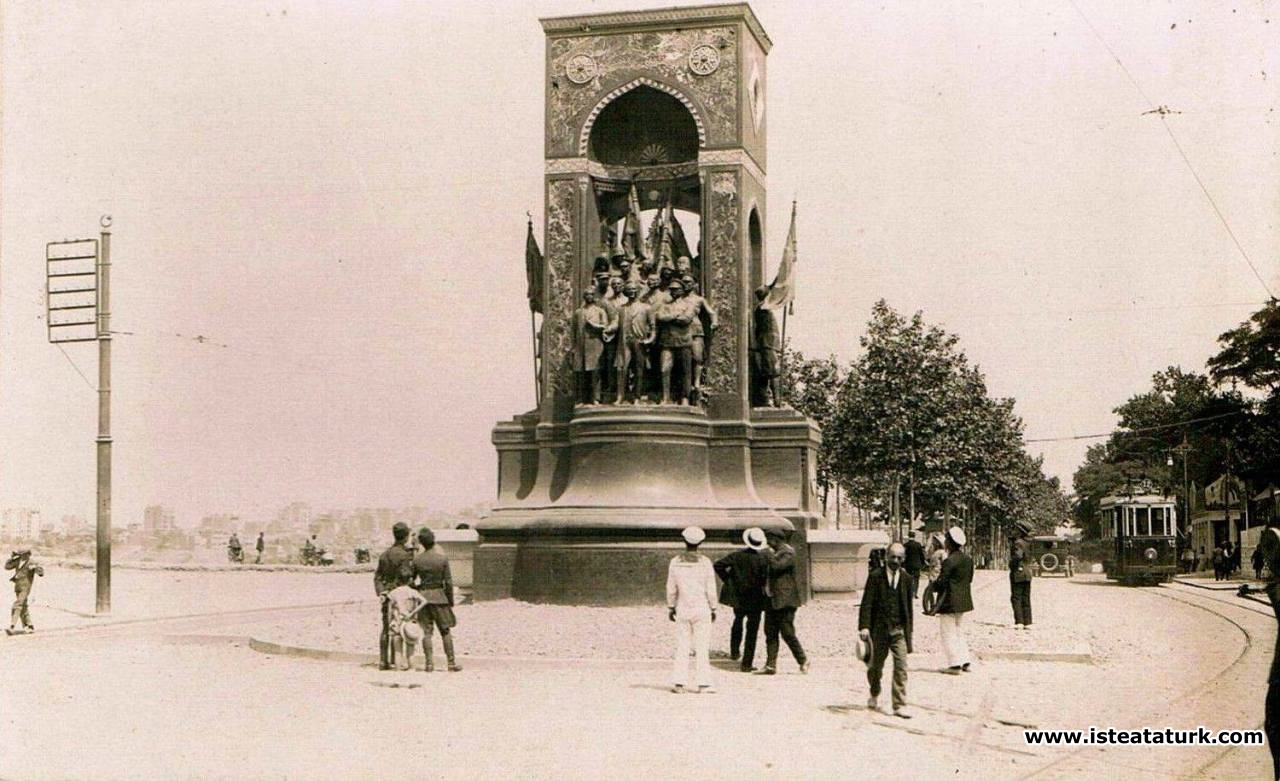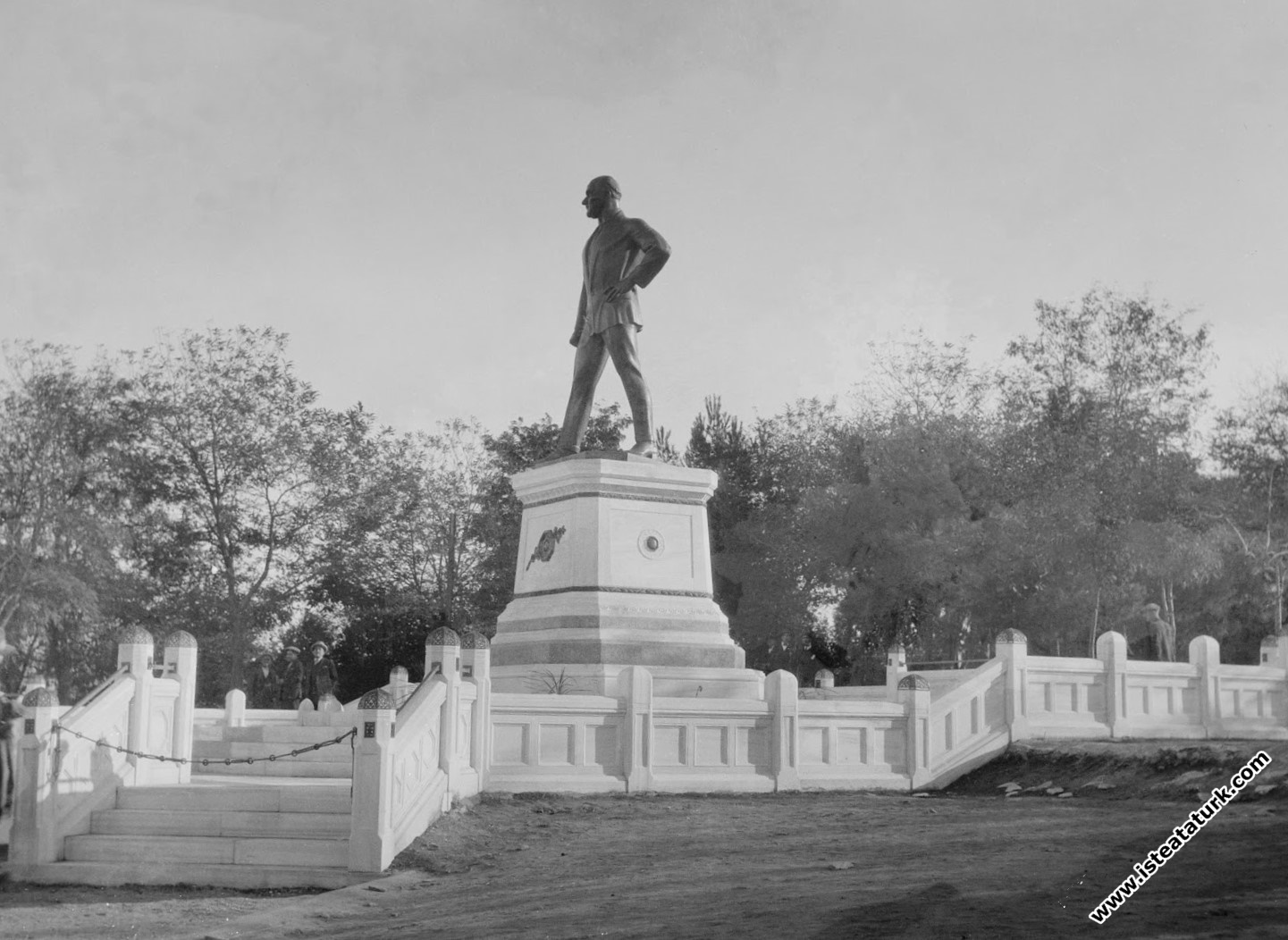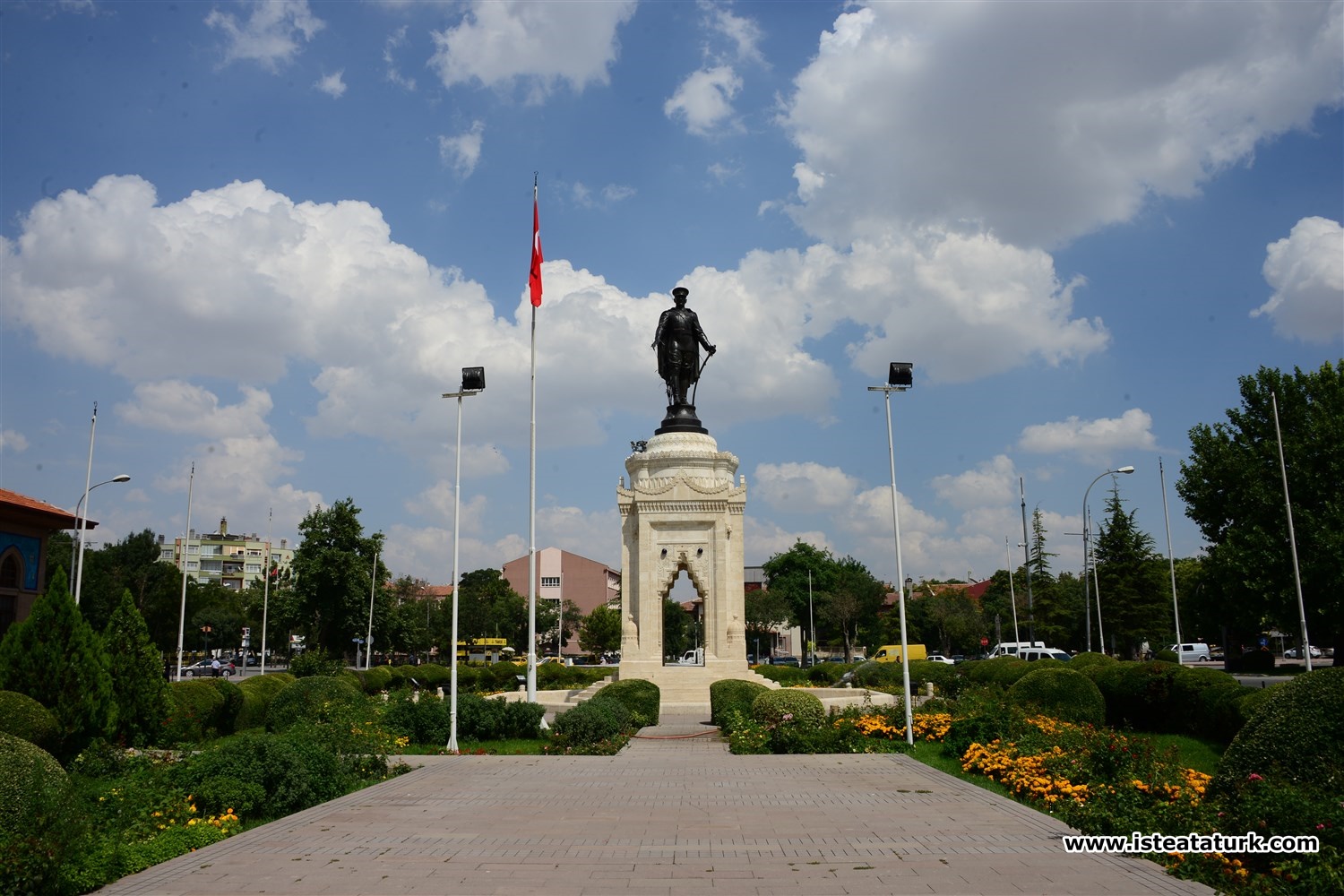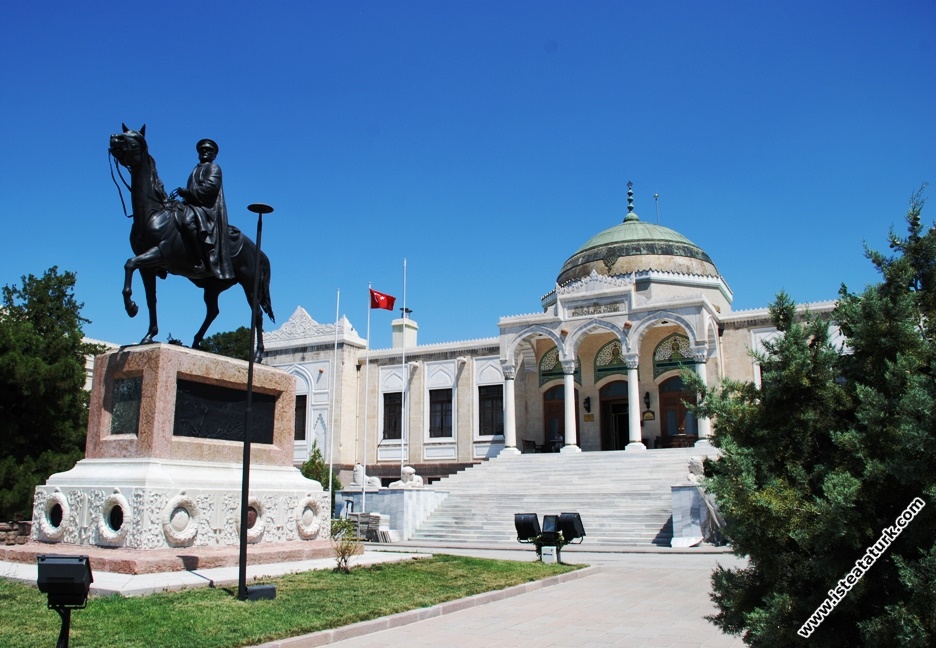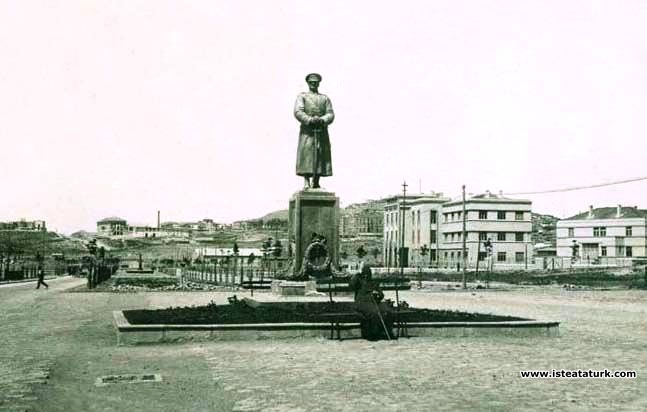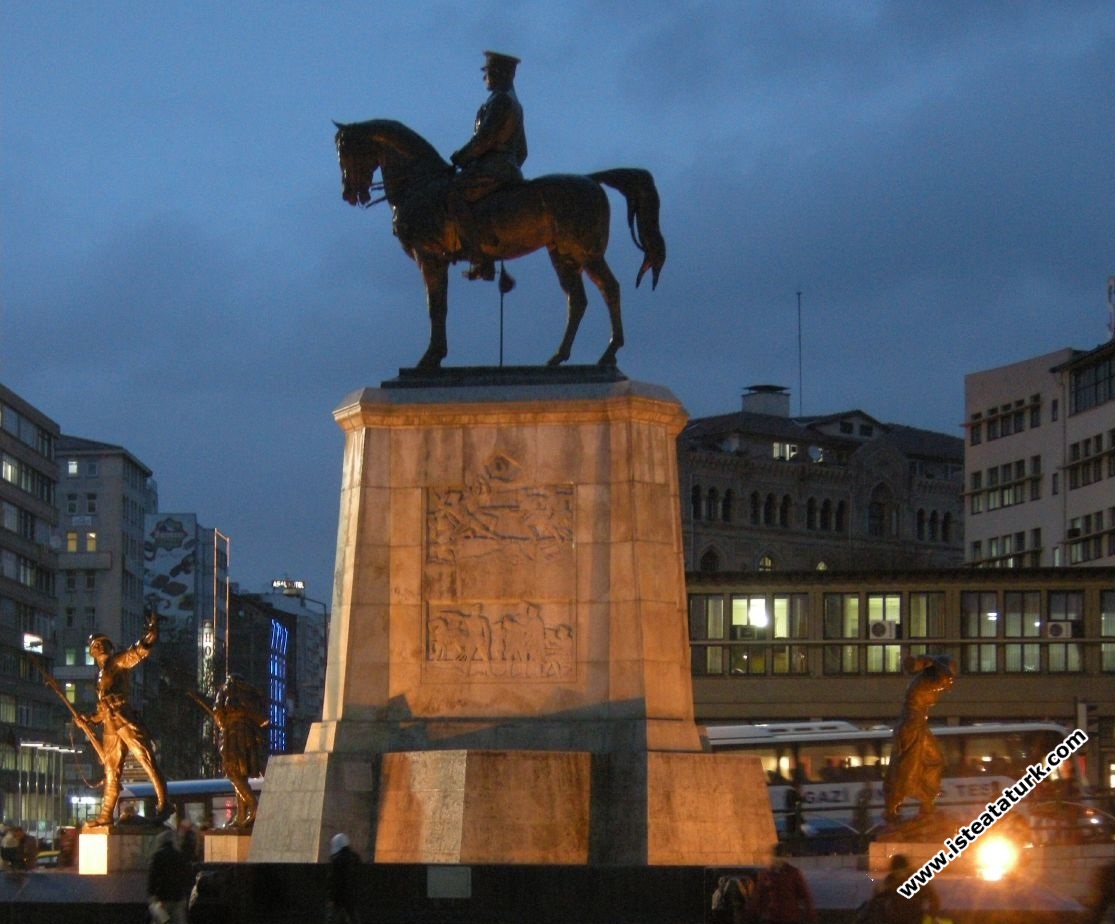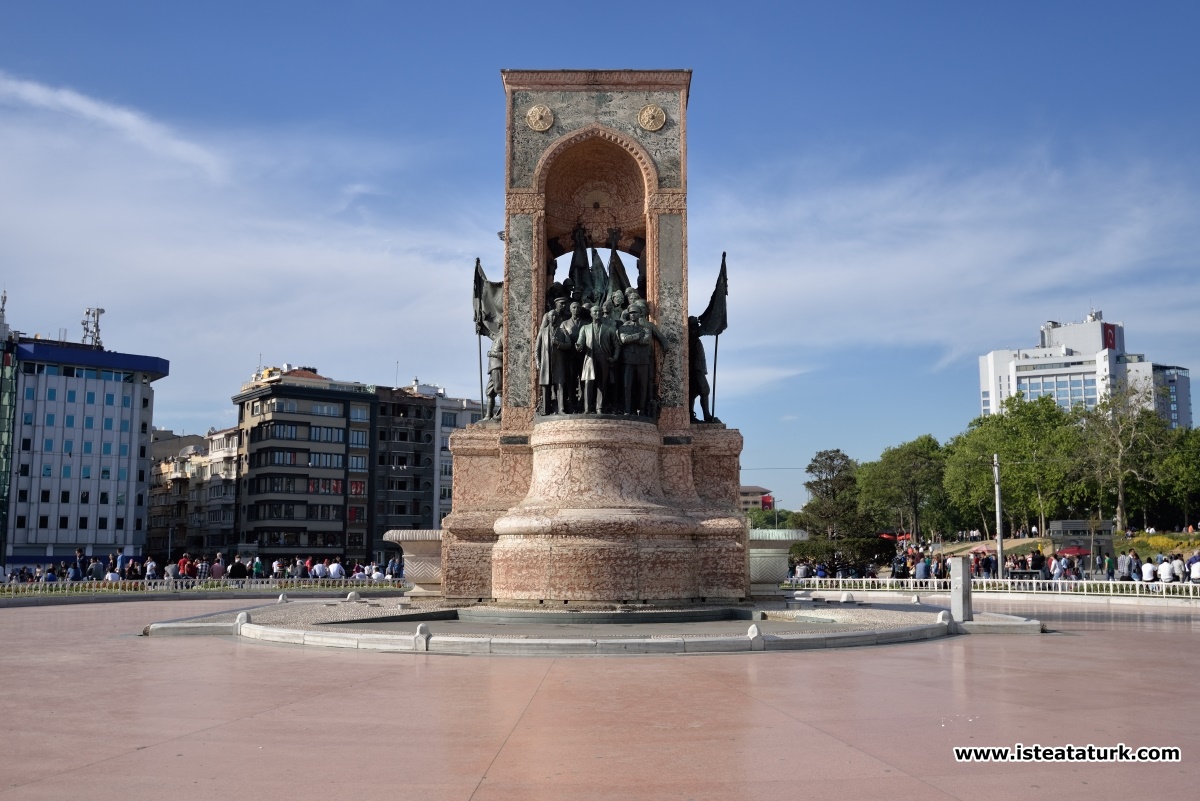
Taksim Republic Monument, Istanbul
Character Size
Taksim Republic Monument, Istanbul
Taksim Republic Monument
LOCATION: Istanbul, Taksim Square
DATE: August 9, 1928 (Eyice 1986;10; Vahit 1930:3)
ARTIST: Pietro CANONICA
MADE BY: Municipality (Banoğlu 1992:111) (Eyice 1986;10; Vahit 1930:3) It was built by a commission established under the Presidency of Istanbul Deputy and Republican People's Party Inspector Hakkı Şinasi Pasha. Mr. Ismail Hakki. Namık İsmail Bey, Halil Bey and Milik Bey are among the commission members (Safa 1933:9). Its construction was decided at the end of 1925 (Anonymous 1973c:232; Ergin 1994:444).
PROJECT FORM: Order (Gezer 1984:89). Competition (Eyice 1986:10).
SELECTION COMMITTEE : Taksim Monument Commission. The model of the monument was approved by the Ministry of National Education (Banoğlu 1992:109).
COST : 16.500 British Liras (Banoğlu 1992:109; Gülersoy 1986:27). With the financial support of Istanbulites. 140.000 TL. (Vahit 1930:4; Gezer 1984:89).
PLACE OF MADE: Italy/Rome
MONUMENT
Material: Sculpture; bronze, Pedestal; Italy/Torina red marble and the green marble of Suza near Turin (Vahit 1930:4).
Dimensions: Sculpture; The height of the figures in the front row is 2 m., the pedestal; 11m.
Inscriptions: On the stone floor where the pedestal sits:
In the north: 30. VIII. 1922
South: 29. x. The dates of 1923
can be seen.
Reliefs: In medallions, in the East; veiled woman, in the West; There is a portrait of a young girl with an open face.
(1).jpg)
History of Taksim Republic Monument
Monument is Tendered
The Taksim Republic Monument was built by the world-renowned Italian Sculptor Pyetro Kanonika for 16,500 British liras, with the leadership of the Istanbul Municipality and the generous donations of the people of Istanbul and the institutions in Istanbul.
On December 1, 1926, the commission convened under the chairmanship of Istanbul Mayor Muhittin Üstündağ made the following decision:
1 - It was deemed appropriate to have the Monument built, as a model for the Monument was made by Monsieur Pyetro Kanonika and approved by the Ministry of National Education.
2 - Since the Head of our commission, Istanbul Deputy Hakkı Şinasi Pasha, is in Ankara, the contract prepared to be signed between the Istanbul Mayor Muhittin Bey, who was deputing for them, and Monsieur Pyetro Kanonika, was discussed and examined item by item, and it was decided to notarize the final form.
3 - It will be completed within 18 months from the date of signing of the contract.
4 - 16,500 British liras will be paid, including the construction and foundation of the Monument.
Kanonika's first report on the monument
Pyetro Kanonika explained what he thought about the Taksim Republic Monument before the agreement was made, in the report he sent to Hakkı Şinasi Pasha, the Chairman of the Monument Commission:
“I would like to thank the states and commission members for the kindness you have shown towards me in order to have the statue of Gazi Mustafa Kemal Pasha built.
Please allow me to present my thoughts on the monument to be built.
In my opinion, a monument to be built in Istanbul should not be satisfied with the statue of Gazi Pasha alone, but the national struggle among the nation should be revived. Within these principles, a great place is given to sculpture and architecture. Such a monument would have adorned and expanded Taksim Square with its historical majesty and architecture.
First Front
Ghazi Pasha will show His Excellency among his nation and his military during the operation in the National Struggle, the result of which is the liberation of the country from the enemies. There will be several cases from this time in perspective in the same group.
Second Front
There is a group that will revive the proclamation of the Republic after the national and military operation that resulted in victory. In this group, His Excellency Gazi Pasha will appear as the president in civilian clothes.
On the Third and Fourth Fronts from the Side
The masts of the unfolded flags are in their hands and the soldiers declaring the victory. There will be two masks on the monument, one of which is the face of a woman under the veil, and the captivity of the old age, on the other hand, the freedom of a smiling woman with an open face, will show the freedom of today's life.
There will be two beautiful basins and a fountain on both fronts at the place that coincides with the feet of the soldiers.
The whole Monument will be on a large and beautiful pool, and the water flowing from the fountains will overflow from the basins and spread into the pool.
At night, especially on official days, the pool will be electrically illuminated, so harmonious colors and landscapes will come into existence.
Essential Substances
The monument will generally be made of red colored stone. This stone harmonizes well with bronze. From this, ornaments will be made by adding yellow and green marbles. People and other figures will be of bronze. The sculptures will be cast in the Cire Perdue method. The height of the persons in the first plan will be two meters.
Kanonika explains at length the procedures to be carried out until the delivery of the statue.
Some Discussion About the Sculptures
Later, some ideas were put forward about the shapes of the monument and Atatürk's clothes, and some of them were not implemented.
On 26.8.1926, Diyarbakır Deputy Inspector Dr. In a letter he sent to the Istanbul Municipality, İbrahim Tali said: “Since it is considered appropriate to make the statues of His Excellency Gazi Pasha, which was decided to be erected in Taksim, on a horse, wearing the Marshal uniform and a hat, he should inform the Abide Society of this matter and about the activities of the Society. I request you to be constantly informed.”
In a telegram he sent to the Istanbul Municipality on 4.2.1927, the Deputy of Education Mustafa Necati said: “The statues of the commander pashas, officers, soldiers and people by standing in Taksim will not be made with heart-shaped hearts, but will be made with today's uniforms or with their heads uncovered. Notification of the result.”
Many such ideas were put forward until the Abide took its present form. In the meantime, many of the information Kanonika requested from Rome was sent by the Istanbul Municipality. We give an example of this.
In the letter dated 8.2.1927, signed by Presidential Secretary General Tevfîk (Bıyıklıoğlu) and sent to Istanbul Mayor Muhittin Bey, it was stated:
“I am reporting the information requested to be used on the statue of His Excellency the President:
1 - Getr and boots are opened from the front in a general way and fastened with a clasp from above. Its height is 32, its widest part, that is, the calf, is 39 cm, and the narrowest part, that is, at the wrist, is 29 cm.
2 - There is no cord on military uniforms.
3 - The epaulettes are made of silver.”
A Decision of the Monument Commission
The Monument Committee convened on Thursday, February 9, 1928, under the chairmanship of Hakkı Şinasi Pasha, and decided on the discussions between the Ministry of Education and the Commission about the sculptures in the Abide.
We make this historic decision exactly:
“- The telegram of the Ministry of National Education stating that the statues of His Excellency, the Gazi, the commander pashas, the officers and the soldiers and the generals that will be erected in Taksim will not be made with heart-shaped caps and will be made with today's uniforms or with their heads uncovered, and the result has been examined at today's meeting of our commission. The work that was decided to be brought to life in Taksim is not a work or institution that consists of individual sculptures or represents an individual event, but is a great monument that will represent its conclusion with the start of the National Struggle. And this monument is decorated with statues representing various historical events around a four-sided arch. One of these fronts represents the great incident that shows how Turkey's national rebellion with the counter-revolution started and how our great Chief started to struggle with his fellow jihadists as a leader of the nation on this path. Here, it is necessary to submit to historical truths and to determine the social situation with the clothes of that day. With the thought and conviction that no one has the right to falsify its history, this front is represented by a snapshot of the Gazi Dumlupınar attack, with the famous war outfit found in Kocatepe, and the privates are shown wearing Kabalak and wearing the clothes of that day. The other side shows the proclamation of the Republic. Here, Gazi was seen with his friends in civilian clothes and open-minded. The Reverend Fevzi Pasha, the Chief of the Erkan-ı Harbiye, and his aide-de-camp, who are on the left side of the Takz, were made with today's military uniforms and caps. The soldiers on the other two fronts, carrying the banner in their hands, are in today's uniforms and have iron helmets on their heads. Our commission found the artist's offer, which was once explained in this way, to be acceptable, and gave the order, as it was not possible to build this monument in any other way, since the General Delegation revived a historical period. In fact, the model of Abide was made by the sculptor Kanonika and presented to high authorities in Ankara before the order was given, approval and consent was obtained. Our commission found the artist's offer, which was once explained in this way, to be acceptable, and gave the order, as it was not possible to build this monument in any other way, since the General Delegation revived a historical period. In fact, the model of Abide was made by the sculptor Kanonika and presented to high authorities in Ankara before the order was given, approval and consent was obtained. Our commission found the artist's offer, which was once explained in this way, to be acceptable, and gave the order, as it was not possible to build this monument in any other way, since the General Delegation revived a historical period. In fact, the model of Abide was made by the sculptor Kanonika and presented to high authorities in Ankara before the order was given, approval and consent was obtained.
However, there is no obvious and contradictory difference between the shape that has emerged today and the demand and desire of the high power of attorney. It is understood from the investigation that the bronze part of the work was cast and completed today. Consequently, it was decided to request Abide, who is in full agreement with the facts and cases, to be accepted by the Ministry of Education as well.”
This discussion was also published in the newspapers, and many ideas were put forward. Hakkı Şinasi Pasha wrote in a private letter from Ankara to Deputy Mayor Hamit Bey:
“According to the contract, the Monument will be supplied. Only the sentences written about Abide in the newspapers left me stuck here. Who reported this to the newspapers? If you or Muhittin Bey have said it, it needs to be corrected by saying, in an appropriate language, 'the job has been misunderstood, there has been no communication between the Ministry of Education and the Municipality about Abide'. If you didn't, tell the journalists that you don't have any information about this and that there is no such communication, and please ask me not to tell the commission member anything about it."
A Controversy of Mentality
While the Taksim Monument was being built in Rome, it was decided that a sculptor who would win the first place in a competition to be opened at the Academy of Fine Arts would be sent to Kanonika for an internship. A young girl named Sabiha Ziya won the first place in the competition, and a student named Hadi Bey won the second place.
The Atatürk Statue Commission was hesitant to send Sabiha Hanım. Sabiha was single, she was 22 years old, she could read and write in French, could understand spoken language, but was deprived of practice. Hadi Bey spoke good French. What made the commission hesitate was the fact that Sabiha lady was a young girl. First, a letter was written to Kanonika asking her opinion. In his reply, Kanonika said: “In my opinion, if it is necessary to choose a male or female student for an art like sculpture, it is necessary to say clearly that it would be right to choose a male, if I think.”
Mustafa Necati, Minister of Education, in a letter he sent to the Taksim Monument Commission on 27.04.1927, said:
“We have been informed by the Mayor of Istanbul that one thousand students of sculptures, which were decided by your High Commission to be sent to work with Monsieur Kanonika, were selected in the competition held by the Council of Fine Arts, and that only this student was a woman, and the sculptor was hesitant to send this student to the commission, and asked the sculptor. For the students who will be sent to Europe by our attorney, the competition is opened and the winner is sent regardless of male or female. Such a separation by your High Commission will have a bad effect among the students who have equal law in our male and female schools. Apart from the fact that their continuity in female or male professions is equally guaranteed, even in our country, the majority of women who are still engaged in art are close to men.
As it is understood from the documents we have, this discussion lasted for a long time, and finally on 27.7.1927, Mustafa Necati, the Deputy Minister of Education, sent the following letter to the Istanbul Municipality Taksim Monument Commission.
It is a reply to your letter dated July 22, 1927.
“It has been decided by proxy that Sabiha Ziya should be appointed before the sculptor Monsieur Pyetro Kanonika. There is no opinion given by the artist, since Turkish morals and character cannot be affected in any way by the influences of the environment, sir."
After this letter of the Ministry of Education, Sabiha Ziya was sent to Kanonika to do her internship by paying 1500 lira per month.
DISPUTES WITH KANONICA
A report by Berç Keresteciyan, a member of the Monument Commission, dated March 11, 1929, explains the disagreements between Canonika and the Commission. We publish the report in full:
Some scientific issues have arisen between the sculptor Monsieur Kanonika and our Commission, and some personal things have been mixed in between these issues:
For example:
a) A few months ago, a letter of complaint was sent to our member Edip Servet gentleman from Italy and it was said that not giving the last installment was just a “chicane” and we were short of money. However, the money for the last installment was fully available in Esnaf Bank.
Since it was in question in the last session, a sneaky vagrant appealed to Monsieur Kanonika and made some absurd accusations addressed to our venerable Chief and therefore to our Commission. Monsieur Kanonika has commanded how ugly things like this are cursing our Reverend Chief and us, and that he will understand what the truth is and work to bring out the men who think hostility towards us.
As for the scientific issues:
a) Monsieur Kanonika's people know very well that our Commission collected the money necessary for the construction of the Taksim Monument from the people of Istanbul and the institutions of Istanbul. Consequently, as our Commission is responsible for them, it considered it an important duty to have Abide examined by a science commission before leveling the last installment to Monsieur Kanonika and had it done.
In its report, the science commission, made up of specialized and famous individuals, found some small nawaqis up from the base of Abide and determined a maximum of four thousand liras (Turkish Liras) for the supply of these wares. The message shown in the aforementioned report was approved by Monsieur Kanonika and they allowed four thousand liras to be deducted from the last installment.
b) As I have presented above, even the inspection of the base of the Monument was considered as a prime minister of our Commission, and Malik Bey, one of the distinguished geology professors of Darülfünun, was offered to examine and examine it, and our request was kindly accepted and a detailed scientific report was given to our Commission. In this report, it is implied that there is no criticism of the fortitude of the pedestal, even that it is text. However, although it was mentioned in our contract that the pedestal would be made of hard marble, Monsieur Canonica made the pedestal from Limestone (calcaire) Breschite in pink color, and therefore, as time passed, some small spouts appeared and small cavities (cavites) would be seen beyond the pedestal, and that it will almost look like the face of a "pox-pox" man, and that it will be ugly from the "esthetique" point of view, and that such gush has already been observed, Malik has sincerely informed our Commission both in his reports and verbally. In addition to this, they also said that the base will be made of real granite marble. When they answered these, Monsieur Kanonika became nervous, assuming that the monument they had made as a result of a crime, was "critical" by Mr. Malik. But be sure that nobody's purpose is criticism. The truth is the desire that there should be no blemishes in the monument of our President, Gazi, whom we all sanctify. Malik sincerely informed our Commission both in his reports and verbally. In addition to this, they also said that the base will be made of real granite marble. When they answered these, Monsieur Kanonika became nervous, assuming that the monument they had made as a result of a crime, was "critical" by Mr. Malik. But be sure that nobody's purpose is criticism. The truth is the desire that there should be no blemishes in the monument of our President, Gazi, whom we all sanctify. Malik sincerely informed our Commission both in his reports and verbally. In addition to this, they also said that the base will be made of real granite marble. When they answered these, Monsieur Kanonika became nervous, assuming that the monument they had made as a result of a crime, was "critical" by Mr. Malik. But be sure that nobody's purpose is criticism. The truth is the desire that there should be no blemishes in the monument of our President, Gazi, whom we all sanctify. But be sure that nobody's purpose is criticism. The truth is the desire that there should be no blemishes in the monument of our President, Gazi, whom we all sanctify. But be sure that nobody's purpose is criticism. The truth is the desire that there should be no blemishes in the monument of our President, Gazi, whom we all sanctify.
After the sculptor Monsieur Kanonika gave assurances and explanations about the type of pedestal stone, they read a report from the famous Italian geologist Professor Kaçamali. It is pleased to see that this report is in agreement with the report of Mr. Malik. However, it has been understood that Kachamali and Malik Bey were not both dissenting with the claim that "as time passes, some ugly pits (even small ones) will appear on the pedestal".
Monsieur Kanonika, on the other hand, says that the base will never be broken, based on his 40 years of experience, and that he never undermined his own honor and dignity, and that he never had the base of the Monument built with a bad stone, on the contrary, due to the respect and affection he had for His Excellency Gazi and the Turks, the Monument was once more beautiful and textual. He has declared that he is trying to be a success and presented a picture book of the statues and monuments built with the same stone in other places in Trentino to His Excellency Hakkı Şinasi Pasha, the Chairman of our Commission.
To sum up and my proposal:
Considering Monsieur Kanonika's global reputation and forty years of experience, a letter of guarantee was signed by Monsieur Kanonika stating that both the statues and the pedestal parts of the Abide are very texts and that they will never deteriorate over time (for example, the pedestal stone) After the original report written by Professor Kaçamali and Professor Kaçamali was submitted to our Commission, 450 British liras were deducted from the balance of 1950 British liras, and the remaining 1500 British liras was leveled to Monsieur Kanonika after a report was received from the Architect Monceri, and this proposal was put on the record and recorded. I beg you, sir.
Berc Keresteciyan
March 11, 1929
From Member of Monument Commission
REPORT OF PROFESSOR MALIK
After the monument was founded, the disagreement between the Monument Commission and the sculptor Kanonika continued for years, and the final installment was not paid due to some cracks in the monument. In the meantime, we give a report on Abide's flaws.
On the eleventh Tuesday of March, I went to Taksim together with Deputy Şehremaneti Hâmit and the Director of the Board of Science, M. Chaput, one of the professors of the Darülfünun and one of the professors of the Darülfünun, to re-examine the red colored limestone that forms the base of the Abide.
In my first report, I stated that this bowl is inhomogeneous and has two parts, some of it is made of dense red limestone, the other part is Ahabevi and serves the role of cement among red limestones, etc.
In order to get a solid idea about the structure of the stone, we made a thin plate from a sample we found on the ground by chance and examined it with a microscope, that the part that plays the role of cement is Habbevish, partly clayey and partly siliceous, that there are calcite crystals in its interior, and that the pink-colored anasir consists of very small crystals. has shown that. In fact, I think it is unnecessary to repeat them here, since he mentioned both this hurdebî investigation and the ability of the stone in the report that he presented to the examiner, which we did together with Professor Chaput.
During my close examination of the base of the monument, I observed that the cracks increased and deepened despite the mild winter this year. In particular, it is seen that these gaps and cracks are located between the two types of elements of the stone, that is, between the parts with the main density and small crystals and the natural cement, and they almost come into contact. It is probable that the stone will fall from the surface five to ten centimeters deep, piece by piece after a few years, and that not even a trace of the angular parts of the pedestal will remain. The fact that another stone of the same type seen on the floor of the Gazi Monument on Sarayburnu is still in pieces is sufficient to give a definite idea on this matter.
In order to prevent the pedestal from breaking down in this way, it is necessary to fill the cracks and gaps with a silicate material resistant to weathering and polish it well, thus preventing the penetration of water. Indicating the architect M. Mongeri, I saw the part of the Abide that was polished and filled with a silicate material; this polish is beautiful and good as it gives the stone its true color and removes the roughness of the stone. However, it is not possible to say anything about the tenacity and strength of the silicate material, this can only be understood next year, after the rainy and snowy seasons. However, the masters who polish and plug the holes need to carefully sort the parts of the stone that have been completely eroded and are about to fall, and especially the edges, with thin steel pencils. Because if this operation is not done, even if the silicate material is hard and durable, the water will still penetrate from the edges and these parts will be poured and the silicate material will remain like a skeleton in the middle. Since the carvings on the upper part of the pedestal are in a state of disintegration, it is necessary to pay close attention to these parts.
I find it useful to give a good polish to the green stone on the upper part of the monument, called "Ophicalcite", and to clean the rough parts that face cracking, from the point of view of the stone's fortitude and strength in the future.
March 21, 1930
Darülfünun and Graduate School of Engineering
Professor of Geology
A. Owner
Canonika Can't Get The Last Installment
A document given to the Istanbul Municipality on this subject:
“Out of the amount of (16500) British lira (2475) British lira on 16 December 1926 and (4125) lira on 10 January 1928, which had to be given to the sculptor Monsieur Kanonika, in return for the construction of the Republic Monument, which was built in Taksim. and (4950) lira on 16 July 1927, (2500) lira on 13 September 1928, and (500) lira on 29 September 1928, and the balance (1950) British lira remained.
Due to the contract, the base of the Abide had to be made of hard stone, but the upper side of the Abide was not paid, as the reports given by a committee of experts stated that the stone used on the base of the Abide was not in compliance with the contract.
At this time, since the Monument Commission did not have enough money to pay the last installment, the amount was guaranteed by the Municipality with the decision of the Community-i Umumiye-i Belediye, as it was believed that such a problem was created, and the Esnaf Bank deposited this money in accordance with the order given by the princes. He had written a letter to Banka Kommrçiyale Italiana stating that he was
Later on, on behalf of Kanonika and on behalf of the architect Monsieur Monceri and Leonardi, one of the clerks of the Italian Embassy, they applied to our Commission and stated that they would cover the holes in the stone with a specially prepared substance and put it in a state where there would be no need for repair and polishing again. and since they stated that they would accept the expense of aging on behalf of Kanonika in this regard, on the account of Monsieur Kanonika on 7 June 1930 and 22 May 1930 (1000) and on 1 April 1930 (1000) Turkish ceman (3000) Turkish The Turkish lira was disbursed to Leonardi, one of the clerks of the Italian Embassy, acting Monsieur Kanonika.
On April 1, 1930, (500) liras were given to Malik Bey and Müderris Monsieur Şapo, one of the professors of the Darülfünun, who were assigned to the examination of the Abide. According to this calculation (1950), the amount of the Turkish lira from the British lira (3500) is also paid.
Monsieur Kanonika requests the bakıyye-i matlub by applying through various documents. We do not know what condition the base of the Monument took after the repair. The balance of the commission's money deposited with İşbank was (245) British lira (7) shilling (10) pence and (352) Turkish lira (40) kuruş on 31 December 1931.
Since there is no possibility of a re-delivery collection and it was made in the name and account of the Abide city and the balance was basically guaranteed by the Municipality, I request that the amount deposited in the Bank be taken to the order of the Municipality, and that the purpose of the work be agreed by the Municipality in the contract office, sir.”
We do not have any other documents as to how the remaining money was paid to Kanonika. However, a memorandum written by the Beyoğlu District Governorate in Istanbul Province in 1934 constitutes the last document about the Abide. Here it is said:
Money paid: 14988 lira 56 cents
“For the monument to be built in Taksim Square in the name of the President of the Republic, the Cem'an (195000) lira ticket, which was allowed to be printed with the memorandum of the provinces dated August 11, 1926, January 10 and May 30, 1927 and June 27, 1928, was issued. According to the calculation brought by the Monument Commission this time, it was seen that a ticket of 146604 lira was spent on these tickets, and the remaining (48396 lira) tickets were returned exactly as they were, so these tickets were canceled with the stamp of "Battal" and destroyed in the same way as this memorandum.
Apart from these, the curriculum of which is written in the (NO:2) table, the veçsenet and the Municipal Committee's deed of 19 March 1932 and 17 October, and the Municipal Committee's mandates dated 19 March 1932 and 17 Teşrinievvel 1933 and no. 12) The decision and documents consisting of parts were also attached and presented for examination and approval, sir.”
Governor and
B.S.M.
OPENING OF THE MONUMENT (8 JULY 1928) From the newspapers of that day
Taksim Republic Monument, which has been the subject of discussion for years, was opened by the Speaker of the Assembly, Kazım Pasha, in front of a crowd of at least 30 thousand people, at 6 pm yesterday evening, with a grand and bright ceremony that will go down in history. It can be said that Taksim Square has never been the scene of such a collective piece of nation and such a lofty view.
Preparations for the opening of the Abide started in the city yesterday afternoon. Cars, automobiles and trams departing from the Istanbul side and the Eminönü point of the bridge carried the crowds of people who started to flow from all over the city to attend the ceremony. After 16.30, there was such a terrible crowd on Beyoğlu Street that it was impossible to walk on the streets from people, from cars and cars blocking the streets, and from the trams that remained in rows on the streets. Finally, towards 17 o'clock, in front of the large crowd, the Municipality completely closed the streets leading to Taksim Square to avoid any accident. In this way, the trams departing from the tunnel were in Galatasaray, and the cars and automobiles coming from Galatasaray returned in front of the English Palace.
Around 17.30, it was seen that the deputies, city representatives, society executives and many other guests who came to attend the ceremony on the streets leading to the Abide, although they were wearing jackets and top hats, a thousand cars, forming a long cordon, started to arrive in order. Thus, at exactly 17.30, all the deputies, ambassadors and commanders in Istanbul and other military persons of various ranks gathered in front of the Abide. Towards 18 o'clock, on behalf of the President of the Republic, Clerk-i Umumi Tevfik (Bıyıklıoğlu) and Chief Adjutant Rusuhi, Deputy Internal Affairs Şükrü Kaya, Deputy Education Minister Necati and General Clerk of the People's Party Saffet Bey came to Taksim Square. Two minutes later, the Italian Ambassador, Signor Orsini Barone, appeared, accompanied by the entire embassy delegation. Müfide Ferit Hanım came after her and at exactly 18 o'clock the President of the Grand National Assembly Kazımpaşa said, He went to Abide with his top hat and jacket. Kazım Pasha, after standing in front of the Abide's white cover with red stars embroidered on it for a minute or two, said to Mayor Muhittin Bey:
"Let's do the opening," he said.
Meanwhile, the Presidential Orchestra began to play the National Anthem. All hats were removed from the heads. Meanwhile, Kazım Pasha took two steps forward. He took a small pocketknife in his hand. He cut the ropes of the white cloth flying with the effect of the wind in one stroke. Now the veil has fallen and the Monument has emerged in all its glory. It was as if at that moment, the huge Taksim Square shook from its place, and thirty and forty thousand people shouted “Live!” their voices continued in echoes like thunder.
THE DISCUSSION OF HAKKI SINASI PASHA
Kazım Pasha, despite the deputies with him, went to the lectern reserved for orators amid endless applause. The lectern was wrapped in a Turkish flag. After a few minutes, Hakkı Şinasi Pasha took the podium and said, “Citizens!” After describing the dark and terrible days that Istanbul went through, he continued as follows:
- At that time, this was really a Taksim square. In those festive days of the enemies, heaps of torment and suffering were distributed from here to the hearts of those who loved their homeland. O Turk! The most oppressed and bleeding square in Istanbul under the feet of the enemy! You were the one who deserved to carry this glorious Monument on your chest, which depicts this whole history of salvation and ascension with the most vivid lines, for this we have planted it on your chest.
When the veil that concealed this Monument fell, we encountered the sacred plate representing this bright morning that opened in the life of the Turk. We greet him together. While we bow respectfully before those who provided our National Liberation and our beloved Republic, let us remember with deep love and gratitude our dear and holy martyrs who died for this cause. This Monument is a history. I congratulate the artist Kanonika, who heard the most important and valuable points of this history and successfully portrayed them in her work, for this edition.
MUHIDDIN ÜSTÜNDAĞ'S DISCUSSION
After Hakkı Şinasi Pasha, Mayor Muhittin Bey took the stand. Muhittin Bey said:
- Allow me to express the feelings of pride and gratitude of the people as the representative of Istanbul, while presenting one of the most beautiful examples of this beautiful revolution and its illustrious creator, made of bronze and stone, to the world's exemplary and appreciation. , gains a new ornament and a new wealth with this magnificent and very meaningful work. Let's celebrate this value.
Let us repeat once again the wish of the great leader, who made us live these happy days:
MEHMET EMIN YURDAKUL'S TALK
After Muhittin Bey, the poet Mehmet Emin Bey took the podium and after re-enacting the view seen when viewed from this hill of Istanbul under enemy boots:
- But I see, none of them are here today... What happened? What miracle made them disappear? Who brought about this change, who made them? Which hero is it?
While Mehmet Emin Bey was asking these questions, there was only one name in the mouth of the apocalyptic crowd that filled the square: Mustafa Kemal...
While talking about this great son of the great nation, the poet said:
— You avoided being an Iskender, an Atilla, or a Yavuz. You are left only as a crownless and throneless Mustafa Kemal.
— Just as the statue of Moses carved by Michelangelo is the work of inspiration, Mustafa Kemal, who was portrayed by Kanonika, the countryman of this great artist, with a spirit that speaks to bronze, is a wonder of the same source. Because Musa and Mustafa Kemal are saviors of the same sex. Mustafa Kemal did what Moses did according to this century. This hero also raised his bronze fist against the pharaohs of the time and took his nation from captivity to freedom.
MUSTAFA NECATI'S DISCUSSION
After Mehmet Emin, Deputy Minister of Education Necati Bey came to the podium. Necati Bey made a fiery speech that was frequently applauded by tens of thousands of people. We give exactly:
- Dear Turkish mothers, the heroic officers and soldiers of our army, who look at me with their bronze faces and their fiery eyes. Great born children of this great nation! At this moment, a sacred sound coming from the ground shaking under my feet, the spiritual hum that surrounds the whole of Istanbul... It creates storms in my soul and in me. The spiritual being in these storms gives us signs and inspirations with the hand of light.
Friends, in a sudden disaster in the middle of Şehzadebaşı, I see the nameless heroes who were martyred while they were guarding the sacred history and independence with their national pride and standing against the whole world with their hearts alone, and now I see the great Mustafa Kemal with their luminous hands.
After giving his last son to his nation, I see that old mothers who died in the snow and storms, while running towards the front in the hills of Ilgaz, to the young independence and liberation army with the young one wrapped around his back and the ammunition loaded on his oxcart, hug Mustafa Kemal with their frozen arms. In front of me, I see the unknown saints and unnamed heroes who left us while fighting against a thousand and one enemies on the edges of Sakarya, hugging the great Mustafa Kemal with the spirituality of the unnamed heroes.
Siblings! Here in front of me, these spiritual and holy beings are crowning the great Mustafa Kemal. I look at the joy flowing from their faces. That joy is an eternal and divine power that gives hope and life to hearts.
Great Mustafa Kemal is a great happiness crowned only by the hands of these holy beings. Its crown is woven from spirituality alone. His throne is the heart of the nation, which carries unlimited loves and talents.
O hero, who is the representative of the spirituality of the Turkish nation, O dear savior, who is the epitome of virtues and greatness.
I am addressing the thousands and tens of thousands of people gathered around your statue who are more than loyal to you, looking into your eyes.
Dear Turkish nation, don't be afraid if a new case or a new storm brings about a new storm... You are a being that has survived a thousand and one waves of disaster and suffering... The biggest storm of the world has passed through your head. The biggest hurricanes hit your chest. After this, no new disaster may arise for you- But if in any day a pain burns your soul, if it torments you in the presence of a realm of mind, look into the eyes of this great Turkish boy whose head is haloed by holy hands, whose heart is the sum of a thousand and one holy things and greatness. Those eyes show you the way to go. That road will lead you to power and success.
Brothers, I look into your eyes, I read meanings in your wide chest, and with the strength of the inspiration I heard before the statue of my beloved leader, I give good news from his mouth: The happy future of our nation is great. It is as big as its size, and it will be large. (Shouts of applause.)
St. Mustafa Kemal, tens of thousands of people who have always been in love with you and you, gathered in this square where foreign scouts, proud and foreign soldiers roamed, are your lovers who are preparing to die for the path you opened and to follow you. They are waiting for you wherever you want, according to your order and sign. (Applause, sighs).
Accept the greetings and gratitude of hearts that reverence in front of your progressing and walking work.
Those who will pass in front of this statue, know that this is a sign of the will and power of the nation.
Those who set their eyes on the Turkish nation and its sacredness and vitality at any time and time! As you pass around this statue, remember the existence of a great nation that created heroism that history has not written, and be afraid of it! Think about creating heroes.
Great Mustafa Kemal, you exist and live a thousand lives!
After Necati Bey descended from the podium amid the applause, Hakkı Şinasi Pasha took the podium again and declared that the ceremony had finally come to an end.
After the ceremony was over, the people came to Taksim Square and visited Abide until midnight.
FEATURES OF THE REPUBLIC MONUMENT
Taksim Republic Monument is at an altitude of eleven meters and in a neighborhood of seventeen meters. The weight of Abide's collection of marbles is 184,800 kilograms. It is 60 square meters. The tachyzafer part of the monument is 3,500, while the other statues weigh 8 tons, that is, 8,800 kilograms.
All the marbles of the Republic Monument were procured from Italy, all the pieces of the Monument, which was made of Trentino's red marble and the green marble of Suza around Turin, were brought to Istanbul by ferry from Italy and assembled in a record 23 days.
The style of the Taksim Monument has a distinctive feature in that it is unlike any other monument in the world.
It represents the Victory of August 30, 1922, in the section of the Abide overlooking the Taksim Garden and portrays Great Atatürk's leap forward. It is seen that soldiers and Turkish women hugged their Ancestors for the salvation of the Turk and attacked forward with him. Atatürk's picture here is the famous picture taken by Ethem Hamdi Bey, who was the photographer of Milliyet newspaper at that time, in Kocatepe during the 26 August Offensive. There is a date of 30.8.1922 under this group.
In the section of the Abide facing Beyoğlu, the Republic of Turkey is portrayed. Here, Mustafa Kemal is seen as a civilian, with İsmet Pasha and Fevzi Pasha on either side. There are citizen communities that carry the Turkish flag behind. Atatürk is portrayed here as addressing the public. Under this part, there is 29.10.1923, the proclamation date of the Republic of Turkey.
On the two sides of the monument, there are Turkish soldiers who are the epitome of heroism, one of them carrying the banner of war and the other of peace. On the upper side, two women are portrayed in an elegant frame, slightly embossed.
An artist said the following about this monument: “By bringing this monument into being, Kanonika has tried to show the whole history of the new Turkey with an elegant and beautiful simplicity. The monument constitutes a very useful work, fused with high ideas, for both Turks and foreigners. There are no symbolic figures in this that can accommodate vague and unclear interpretations. The artist wanted to introduce the liberation and independence history of Turkey, which has come to life, to future generations with this monument, and he actually succeeded in this regard.”
Niyazi Ahmet Banoğlu
Souce: ATATÜRK ARAŞTIRMA MERKEZİ DERGİSİ, Sayı 25, Cilt: IX, Kasım 1992
Taksim Republic Monument Images
